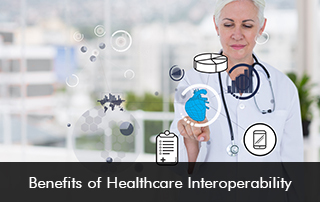Interoperability is the key fundamental to supporting seamless data exchange between software systems. It also presents data in a way that can be easily comprehended by the stakeholders in the healthcare sector. Health information exchange in the Electronic Medical Records (EMR) Software system involves the transfer of all health-related data including; patient medical history, medication lists, medical records, and clinical summaries. All this health data is vital to improve patient safety levels and ultimately enhance patient outcome levels.
Interoperable Environment
The Healthcare IT News revealed that almost 75% of healthcare organizations have reached an elementary level of interoperability. This reflects that the healthcare system is moving towards an interoperable environment to support effective, continuous, and reliable data exchange.
3 Advantages of Interoperability for the Healthcare Sector
Reduction in Medical Errors
Widespread interoperability helps providers to achieve enhancements in opioid prescription and also helps to reduce any medical errors. According to an analysis of medical data about 9.5% of deaths are a result of medical errors in the United States. The analysis also suggested that medical error rates are greater in the U.S. as compared to other developed countries. Interoperability options in the EHR software enhance patient safety as data can be shared across different systems and organizations.
Having access to quick, real-time data providers can improve medication safety with the data at hand. Care coordination between different healthcare providers also enhances which helps to improve the treatment path of the patient. When the physician knows all pre-conditions of a patient, any clinical errors can be reduced and patients can be prescribed the safest medication to improve prevailing health conditions. Being interoperable means healthcare organizations are more empowered with better information and better decision support.
Improved Efficiency
Interoperability makes it possible for data to be available in real-time which helps to increase the efficiency levels of healthcare organizations. With interoperable data, clinicians can quickly detect the main cause of a patient’s illness which can help reduce fatal death rates as quick and informed treatment can be offered with the data that is made available due to interoperability.
When data can be exchanged easily within systems the level of physician burnout can be reduced as providers don’t need to repeat mundane tasks. This helps to improve the care delivery process as providers are charged to offer quality care with resourceful workflows.
Precise Public Health Data
Interoperable systems support quick and accurate collection and clarification of public health data. This helps healthcare organizations answer questions vital for patients and providers to effectively resolve and find solutions to a crisis such as the opioid crisis and the COVID-19 pandemic. The seamless sharing of such data helps educate providers, governments, and professionals to predict and prevent epidemics to enhance patient safety levels at large.
Moving ahead
Interoperability in healthcare provides numerous benefits to the patient in terms of improved opportunities for quality care and patient safety. Interoperability also makes information sharing more secure and protected to offer a better patient experience.
To excel the healthcare sector must strive towards interoperability by selecting the right health information technologies and by adapting to data standards. It will take time for the U.S. healthcare sector to completely become interoperable which can effectively provide accurate treatment.






